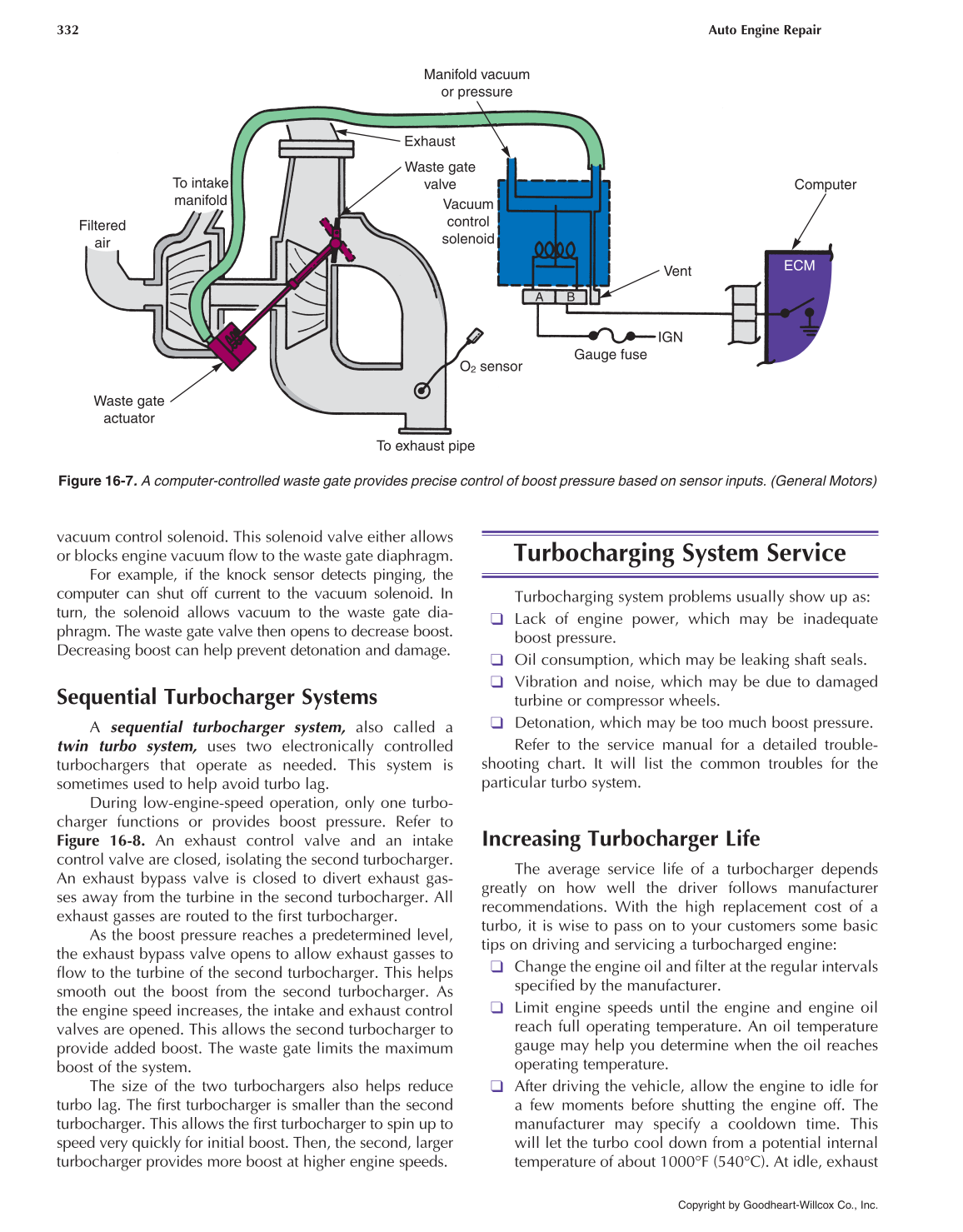Copyright by Goodheart-Willcox Co., Inc.
332 Auto Engine Repair
Filtered
air
To intake
manifold
Manifold vacuum
or pressure
Waste gate
valve
Exhaust
Vent
Computer
ECM
Vacuum
control
solenoid
IGN
Gauge fuse
O2 sensor
To exhaust pipe
Waste gate
actuator
A B
Figure 16-7. A computer-controlled waste gate provides precise control of boost pressure based on sensor inputs. (General Motors)
vacuum control solenoid. This solenoid valve either allows
or blocks engine vacuum flow to the waste gate diaphragm.
For example, if the knock sensor detects pinging, the
computer can shut off current to the vacuum solenoid. In
turn, the solenoid allows vacuum to the waste gate dia-
phragm. The waste gate valve then opens to decrease boost.
Decreasing boost can help prevent detonation and damage.
Sequential Turbocharger Systems
A sequential turbocharger system, also called a
twin turbo system, uses two electronically controlled
turbochargers that operate as needed. This system is
sometimes used to help avoid turbo lag.
During low-engine-speed operation, only one turbo-
charger functions or provides boost pressure. Refer to
Figure 16-8. An exhaust control valve and an intake
control valve are closed, isolating the second turbo charger.
An exhaust bypass valve is closed to divert exhaust gas-
ses away from the turbine in the second turbocharger. All
exhaust gasses are routed to the first turbocharger.
As the boost pressure reaches a predetermined level,
the exhaust bypass valve opens to allow exhaust gasses to
flow to the turbine of the second turbocharger. This helps
smooth out the boost from the second turbocharger. As
the engine speed increases, the intake and exhaust control
valves are opened. This allows the second turbocharger to
provide added boost. The waste gate limits the maximum
boost of the system.
The size of the two turbochargers also helps reduce
turbo lag. The first turbocharger is smaller than the second
turbocharger. This allows the first turbocharger to spin up to
speed very quickly for initial boost. Then, the second, larger
turbocharger provides more boost at higher engine speeds.
Turbocharging System Service
Turbocharging system problems usually show up as:
Lack of engine power, which may be inadequate
boost pressure.
Oil consumption, which may be leaking shaft seals.
Vibration and noise, which may be due to damaged
turbine or compressor wheels.
Detonation, which may be too much boost pressure.
Refer to the service manual for a detailed trouble-
shooting chart. It will list the common troubles for the
particular turbo system.
Increasing Turbocharger Life
The average service life of a turbocharger depends
greatly on how well the driver follows manufacturer
recommendations. With the high replacement cost of a
turbo, it is wise to pass on to your customers some basic
tips on driving and servicing a turbocharged engine:
Change the engine oil and filter at the regular intervals
specified by the manufacturer.
Limit engine speeds until the engine and engine oil
reach full operating temperature. An oil temperature
gauge may help you determine when the oil reaches
operating temperature.
After driving the vehicle, allow the engine to idle for
a few moments before shutting the engine off. The
manufacturer may specify a cooldown time. This
will let the turbo cool down from a potential internal
temperature of about 1000°F (540°C). At idle, exhaust
